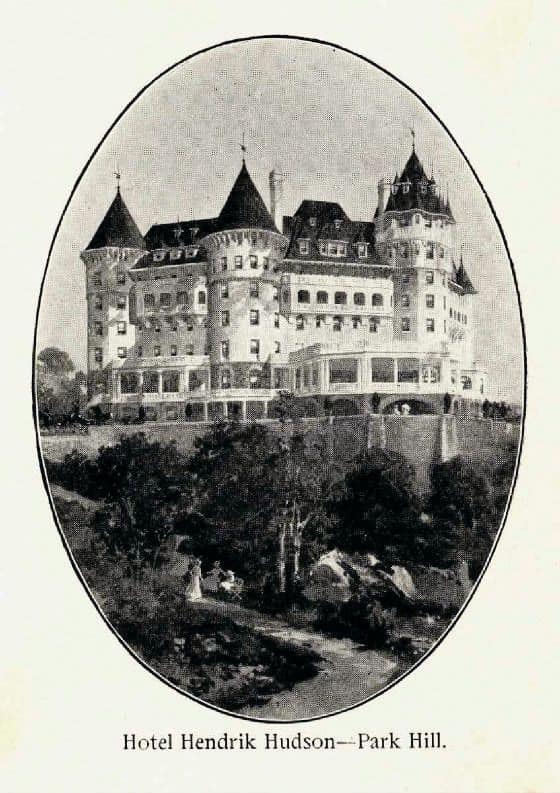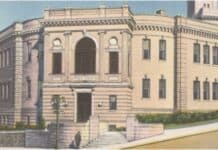By Mary Hoar, President Emerita, Yonkers Historical Society, recipient of the 2004 Key to History, President Untermyer Performing Arts Council

Monday, March 29th
March 29, 1933: Assemblyman William Condon, after introducing legislation in his attempt to lower the toll of deaths and injuries caused by drivers with junior licenses, complained that upstate legislators were blocking his efforts.
March 29, 1934: Cottage Lawn, homestead of the Ludlow family, was torn down. Erected over a period of 3 years on Fairfield Road, Cottage Lawn was the first house built in the Ludlow section of Yonkers. Several new modern six and seven room homes were to be built in the Colonial and English architecture.
March 29, 1946: Civic leader John J. Flynn, questioned why not all former mayors were displayed in the City Manager’s Reception Room at City Hall. He noted several former Mayors were missing, including then Mary Curtiss Frank. Flynn, who collected pictures not only of mayors but also prominent citizens, noted Mayor Fogarty, who served from 1928 to 1931, was the last mayoral picture hung there.
Tuesday, March 30th
March 30, 1963: Andrus Pavilion, located on the northern portion of the Untermyer estate, was officially dedicated. It was the new home of St. John’s Riverside Hospital, the county’s oldest institution for the ill and the first on the Hudson River between New York and Albany when it was incorporated in 1870. The hospital had its beginning in a small house on Warburton Avenue, moved to the Grove House on Woodworth and then took over the Ashburton Avenue Property. S
Designed by Rogers and Butler and built by Walter Kidde Constructors, the pavilion had the most modern equipment in all departments, including a telephone for every patient and a TV set for every room. Solariums on every floor had a river view.
Wednesday, March 31st
March 31, 1887: The Getty House was sold for $125,00 to Franz Blatzhein.
March 31, 1912: Dread ran high among Yonkers residents as many homes were shaken by what they feared was an earthquake. Turns out a powder factory in Patterson, NJ, exploded and the explosion was felt here!
March 31, 1917: Yonkers Mayor James Lennon asked all Yonkers churches to hold special services while Congress deliberated on the crisis in Europe and the possible entry of the US into the war.
Thursday, April 1st:
April 1, 1942: To aid the war effort and save metal, New York State legislated just one license plate on the back of the car, instead of two. Peter Dauenehimer, head of the Association of Fire Auxiliaries, decided to customize an old plate. He painted the old plate white, then stenciled “Boost Yonkers” and a Fire Auxiliary emblem on it and proudly mounted it. Why? First, he wanted to boost Yonkers and counteract anyone knocking our town; to aid his passage and identify him when on the way to his post during an air raid alarm; and lastly, to fill the now vacant space on the front of his car
April 1, 1944: Eleanore Benedict and Isabelle Russell of the Red Cross Motor Corps discovered what generous children lived in Hilltop Acres! The women were driving the Mobile Canteen that was equipped with a PA system. Little Rosemary Kane ran up to them, and held out her tiny fist clutching a penny. Rosemary told them the money was meant to buy candy, but she would rather give it to the Red Cross. She asked them to wait, and returned with eleven more cents, all she had in her piggy bank. Other neighborhood children saw what Rosemary was doing, and ran into their homes. Audrey Cotter, Sandra Kollar, Donald Ready and Barbara Weekly donated their savings, ranging from a nickel to a quarter!
Friday, April 2nd
April 2, 1901: Dynamite brought down a portion of the ruins of the Hendrik Hudson Hotel in Park Hill. Destroyed by a fire a short time before it officially opened, Yonkers authorities decided the demolition process needed to be hurried. Not only was it dangerous, dozens of people constantly visited the remains, not realizing they could be crushed by falling walls or chimneys. Workmen, directed by Foreman George Stewart, worked most of the day drilling holes and setting nine sticks of dynamite. Wires from the dynamite were attached to a battery… and they waited. They did not know where the debris would fall, so the blast was delayed until after the 4:30 train passed, just in case some fell on the tracks. When they were ready, a flagman was sent down the tracks to prevent trains from passing, and then the blast was set off. The chimney rumbled and fell. The tower took down the girders and the elevator shaft frame, forming a pile about ten feet deep, covering the tunnel opening in the rock. The men were pleased with their work.
Saturday, April 3rd
April 3, 1930: With only an overcoat button as a clue, police solved a series of thefts of brass railings from graves at Oakland Cemetery.
April 3, 1944: City Controller Robert Montgomery announced he canceled the proposed sale of nine tax liens against part of the Greystone estate, country home of the late Samuel Untermyer. The heirs had withheld back taxes as they were suing to force the city to exempt the portion incorporated into Untermyer Park and Gardens on the grounds this part of the grounds were used by the public as a park.
Sunday April 4th
April 4, 1945: Proving the point that Yonkers parents encouraged their children to be generous to social causes, Jim Savage, son of Patrolman William Savage, donated his savings to the Yonkers Red Cross campaign. As Red Cross volunteer Julie Schuman was leaving the Savage home, young Jim ran after her, calling out, “Wait, here’s mine.” He donated a quarter; his dad suggested he donate a bit more. James ran back, and poured one more quarter and fifty pennies into Mrs. Schuman’s hands. When she thanked him for his generosity, he looked up at her and said, “I wish I could give blood, too.”
April 4, 1947: Newspaper columnist and author Charles Driscoll of Glenbrook Avenue published his newest book, Country Jake, the story of his life growing up on a farm in Kansas. Driscoll was the writer of “New York Day by Day” newspaper column, succeeding the late O. O. McIntyre. He began his journalism career in Kansas, rising to Editor of the Wichita Eagle, but was forced out of that position by the Ku Klux Klan. Driscoll later worked for the McNaught Syndicate
For more information on the Yonkers Historical Society, Sherwood House and our upcoming events, please visit our website www.yonkershistoricalsociety.org, call 914-961-8940 or email yhsociety@aol.com.





